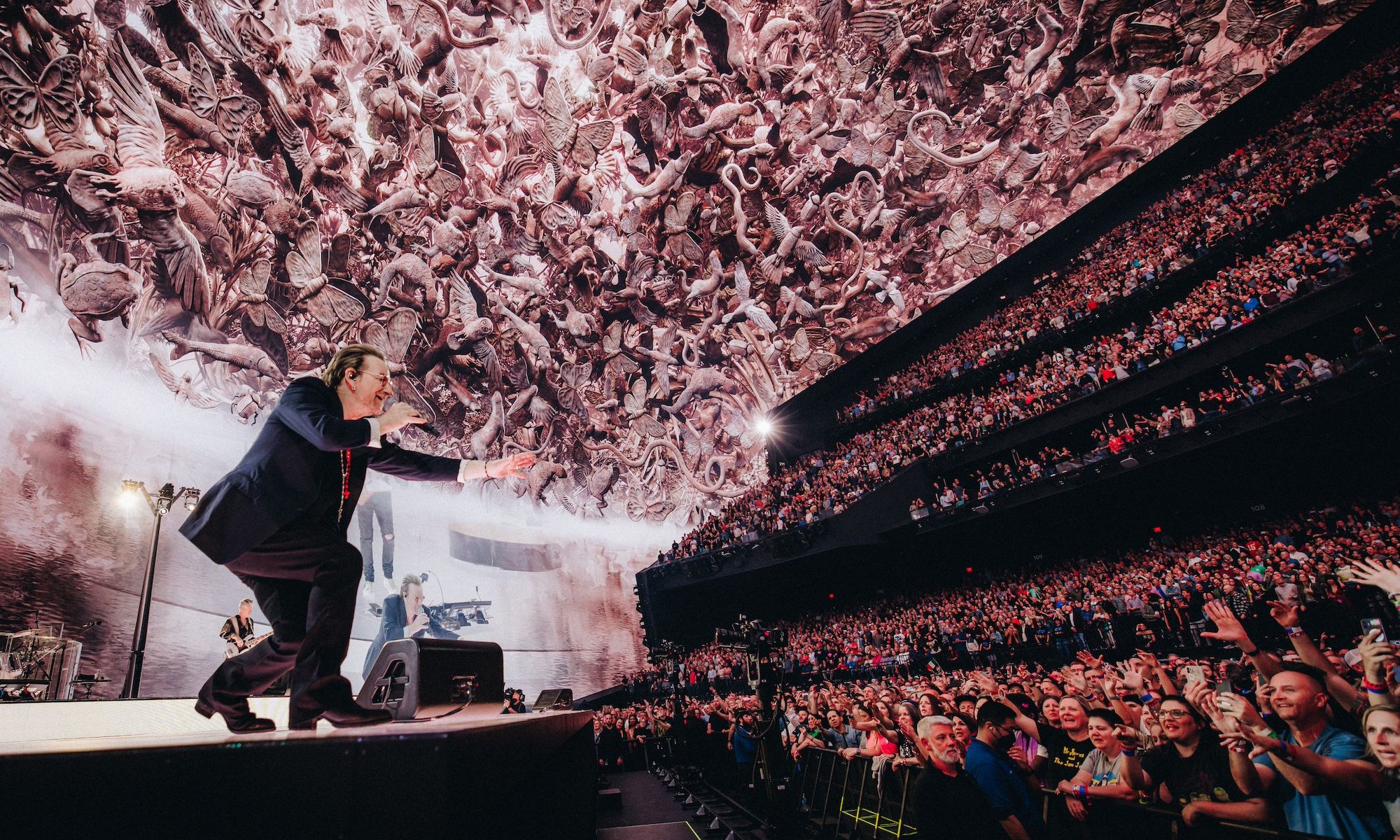U2's Bono performs at Sphere in Las Vegas, with Es Devlin's video work Nevada Ark on the screens above Rich Fury
Leave it to a city like Las Vegas to show you that there are different kinds of disorientation. There’s that sense of being completely spun around and stuck deep in the smoke-filled maze of a mega-casino against your will or better judgment, and there’s the experience, which I had more than once during the visual spectacle of U2: UV Achtung Baby Live at Sphere, of totally losing your bearings and feeling happy to go along for the ride. When Bono sang Who’s Gonna Ride Your Wild Horses, shooting stars streaked overhead thanks to a 16K, wrap-around video screen (a cool breeze might have also been pumped into the concert hall) in a way that felt like sitting outside under a desert sky at night. Later, to the chords of Ultra Violet (Light My Way), red flares shot into the sky, creating mesmerising clouds of fire.
It was a powerful experience—somewhere between the old-school pleasures of a planetarium and the immediacy of virtual reality (more thrilling without the headset!)—and nonetheless disorienting. I felt adrift in this sea of imagery and also unsure of what I was watching. Was it an animation or artwork, or some special effects? Was it created by humans or artificial intelligence? And do these distinctions even matter in a city where the line between art and commerce is routinely obliterated in the name of the deity known as Spectacle?
U2 perform at Las Vegas's Sphere Rich Fury
These are just some of the questions raised by the inaugural video programme at Sphere, the new concert venue in Vegas designed to compete with the theatrics of Beyoncé’s Renaissance tour and immersive Van Gogh experiences alike. With an expansive 15,000 sq. m wraparound screen hiding nearly 160,000 speakers, Sphere has been billed as the largest LED screen in the world and even a “new medium” by its creators at MSG. Only it actually features an established genre, as it overnight became one of the biggest venues in the world for video art. (Exosphere, the name for Sphere’s exterior screen, is the perfect canvas for images of eyeballs or globes, but otherwise not as powerful.)
Developed by U2’s longtime creative director Willie Williams, the visual programme features—along with plenty of blown-up images of Bono and the gang—work by four contemporary artists: Marco Brambilla’s Elvis homage King Size, Es Devlin’s endangered species tribute Nevada Ark, examples from John Gerrard’s Flag series and some luminous turntable images from musician-artist Brian Eno.
But only Brambilla and Devlin’s work were stylistically distinct enough to read as artworks. Brambilla stitched together over a thousand movie clips referencing Elvis and Vegas to create one of his characteristic scrolling video tapestries, the Bosch-like delirium of imagery being his recognisable signature at this point. And Devlin created an awe-inspiring digital tapestry featuring 26 hand-drawn examples of fantastic-looking but real species in Nevada on the verge of extinction, which grew from her Come Home Again installation in the gardens of the Tate Modern.
U2 performs at Las Vegas's Sphere backed by a work from John Gerrard's Flag series Rich Fury
The other artworks were largely subsumed by the concert theatrics, Sphere being a great leveller of video art in much the way the internet is with photography. Who cares about authorship when a flood of stunning images is washing over you?
That was true of Gerrard’s work Western Flag, which I imagine most people read as an illustration of U2’s protest-heavy lyrics. It was also the case with Brian Eno’s turntable, a video projection that created a new (false) stage for the musicians that changed colours over the course of a song or two and just read like a cool stage effect.
U2 performs at Las Vegas's Sphere against a video backdrop created by Industrial Light and Magic Stufish
Complicating the authorship or artistry issue are the nearly a dozen animations or videos, mainly directed by Williams or his London agency, Treatment Studio, mixed in with the commissioned artworks. They range from a charmingly simple animated balloon that Bono leads by its “string” as he walks around the stage to an ultra-realistic, neon-filled Vegas cityscape that eventually disintegrates into a natural desert landscape, like the history of greedy land development reversing itself.
The unexpected appearance of this night-time Vegas scene was probably the most powerful example of Sphere technology in action. Suddenly the band seemed to be playing in front of the real, blinking city skyline complete with its colour-shifting Ferris Wheel instead of in front a screen picturing such things. Out of some stubborn journalistic habit I asked who created that piece, and it turned out to be a team at George Lucas’s visual effects company Industrial Light and Magic. And there it was, the category that best describes Sphere’s leading video art and special effects alike, the condition that so much digital imagery today aspires to: magic.

